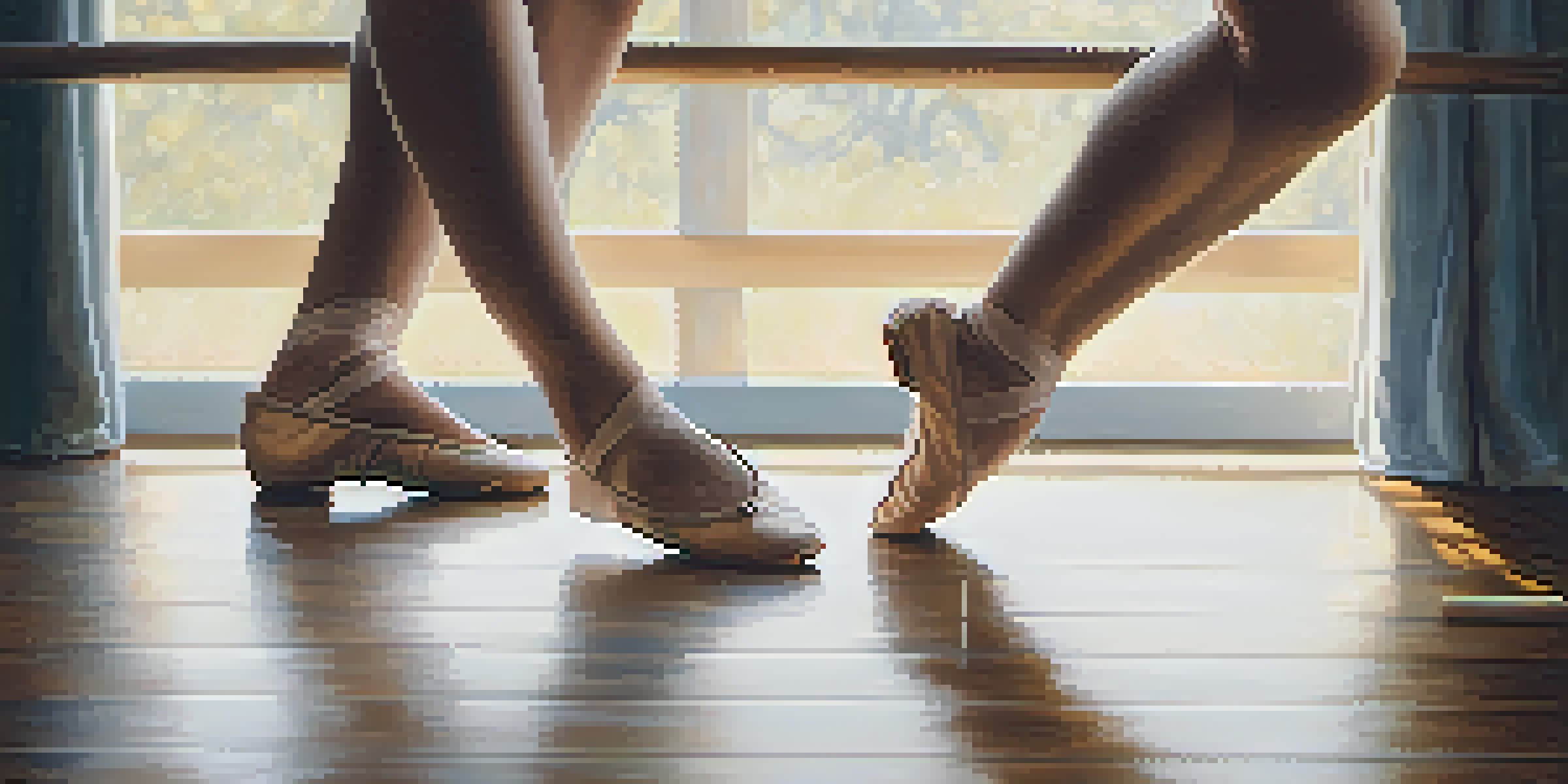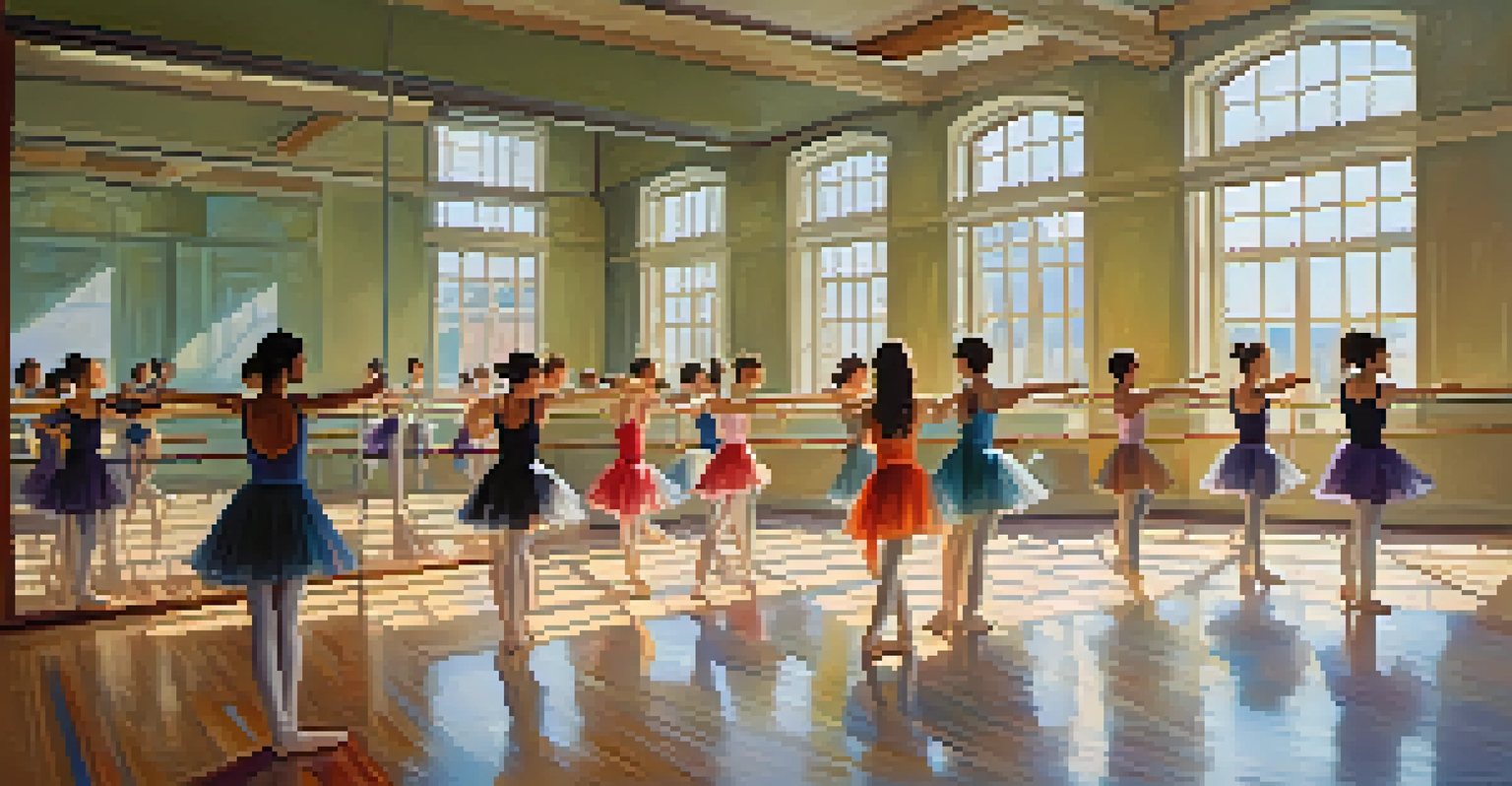Dance Education: Its Impact on Physical Health of Students

Understanding Dance Education and Its Importance
Dance education goes beyond just learning steps; it encompasses physical movement, artistic expression, and cultural appreciation. It provides students with a structured environment to explore various dance forms and develop their skills. This holistic approach not only nurtures creativity but also promotes a sense of belonging among students.
Dance is the hidden language of the soul.
Moreover, dance education can be an effective tool for fostering teamwork and collaboration. As students work together in classes or performances, they learn to support one another, building strong social bonds. This supportive environment enhances their overall school experience, making them more engaged and motivated learners.
In essence, dance education lays the groundwork for a well-rounded educational experience. It combines physical activity, creativity, and social skills, making it an invaluable part of a student's development. The impact of this multifaceted approach is profound, especially when considering the physical health benefits.
Physical Activity: A Core Component of Dance
At its core, dance is a form of physical activity that requires strength, flexibility, and endurance. Regular participation in dance classes can significantly increase students' overall fitness levels. This not only helps them maintain a healthy weight but also enhances cardiovascular health, which is crucial for their physical well-being.

Furthermore, dance involves a variety of movements, which can improve coordination, balance, and agility. These skills are not only beneficial for dance but also translate to other sports and physical activities. As students become more adept in movement, they gain confidence in their physical abilities, encouraging them to stay active.
Dance Education Enhances Well-Being
Dance education supports students' physical and mental health, fostering creativity, community, and self-expression.
In this way, dance serves as a fun and engaging way to incorporate physical activity into students' lives. It encourages them to move and be active, which is particularly important in today’s sedentary lifestyle. The more they enjoy moving, the more likely they are to continue being active outside of dance.
Mental Health Benefits of Dance Education
Beyond physical health, dance education plays a vital role in supporting mental health. Dancing allows students to express their emotions in a constructive way, which can alleviate stress and anxiety. This emotional outlet can be especially beneficial during challenging times, such as exam periods or personal struggles.
Dance is the joy of movement and the heart of life.
Moreover, the discipline required in dance fosters a sense of achievement. As students learn new skills and master choreography, they experience boosts in self-esteem and self-worth. This newfound confidence often spills over into other areas of their lives, encouraging them to tackle challenges head-on.
Dance also promotes social interaction, which is crucial for mental well-being. Being part of a dance community provides students with a support network, reducing feelings of loneliness and isolation. These connections are essential for developing resilience and coping strategies throughout their lives.
Dance as a Tool for Enhancing Discipline and Focus
Engaging in dance requires a significant level of discipline and focus, qualities that extend beyond the dance floor. Students must practice regularly, memorize choreography, and pay attention to their instructors. This commitment fosters a strong work ethic and the ability to concentrate, which are invaluable skills in both academic and personal settings.
The structure of dance classes encourages students to set goals and work toward them. Whether it’s mastering a difficult routine or preparing for a performance, this goal-oriented mindset can translate to their studies. Students become more adept at managing their time and prioritizing tasks, leading to improved academic performance.
Physical Activity Through Dance
Engaging in dance promotes fitness, coordination, and a lifelong appreciation for physical activity.
Ultimately, the discipline learned through dance can have lasting effects on students' lives. It instills a sense of responsibility and dedication, qualities that are essential for success in any field. By cultivating these traits through dance, students are better prepared to face future challenges.
Improving Body Awareness and Posture Through Dance
Dance education significantly enhances body awareness, helping students understand their physical capabilities and limitations. This awareness is crucial for maintaining good posture and preventing injuries. As students learn to control their movements, they develop a stronger connection between their mind and body.
Proper posture is essential not just in dance but in everyday activities like sitting in class or standing while waiting. Through dance training, students become more conscious of their posture, leading to healthier habits. This is particularly important in a world where many spend hours hunched over screens.
As students become more aware of their bodies, they also develop a greater appreciation for physical health. They learn the importance of taking care of their bodies, which leads to healthier lifestyle choices. This newfound awareness can have a ripple effect, influencing their peers and families to prioritize health and wellness.
The Social and Community Aspects of Dance Education
Dance education often brings students together, fostering a sense of community and belonging. Whether through group classes or performances, students learn the value of collaboration and teamwork. This social interaction helps them build relationships and develop essential communication skills.
Additionally, participating in dance can encourage students to engage with their wider community. Many dance programs involve outreach performances or community events, allowing students to share their passion with others. This connection strengthens their sense of identity and helps them appreciate the arts.
Discipline and Focus from Dance
The practice of dance instills discipline and focus, equipping students with valuable skills for academic and personal success.
Being part of a dance community not only enhances social skills but also enriches students' lives. It provides them with a supportive network, encouraging them to pursue their passions and celebrate their achievements together. Ultimately, these experiences contribute to their overall happiness and well-being.
Long-Term Health Benefits of Dance Education
The benefits of dance education extend far beyond the classroom, impacting students' long-term health. Engaging in regular physical activity through dance can lead to a lifetime of good health habits. Students who dance are more likely to continue being active as adults, reducing their risk of chronic diseases.
Moreover, the skills and confidence developed through dance can encourage students to pursue other forms of exercise. Whether it’s joining a sports team, practicing yoga, or simply staying active in their daily lives, the principles learned in dance can guide their health choices for years to come.

In conclusion, dance education is not just an art form; it's a vital component of a student's physical and mental health. By fostering a love for movement and providing a supportive community, dance education sets students on a path toward lifelong health and wellness.